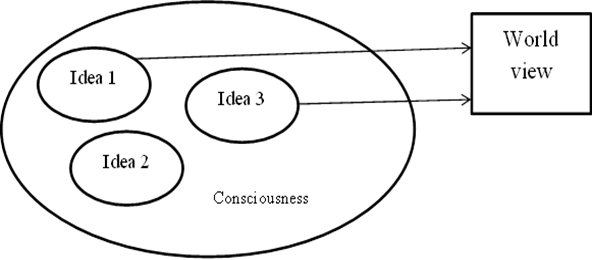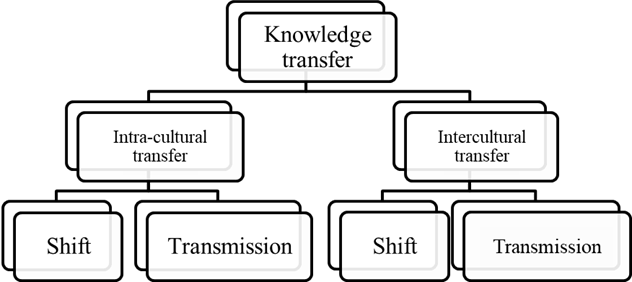Abstract
At the present stage of the development of science, the knowledge transfer is gaining more and more interest of scientists in various scientific fields. However, it should be noted that, despite the relatively high level of interest of researchers in the process of linguocultural transfer of knowledge, nowadays there is no proven methodology for studying this process. This article reveals the concept of knowledge transfer and it is devoted to the study and systematization of its types, as well as a description of the features of different types of transfer. The problem of typologizing the linguocultural transfer of knowledge has not been studied enough, but due to the increasing interest of scientists in various fields of science in the theory of transfer of knowledge, this issue requires more thorough research. The article analyzes the scientific research of Russian and foreign scientists in the field of typology of knowledge transfer. The author gives a generalized description of different types of transfers based on an analysis of the views of different researchers. In total, four main features have been identified by which the transfer of knowledge can be differentiated. As part of the study, an attempt was made to generalize the existing classifications. The publication also touches upon the importance of determining the place of the transfer situation in the classification, paying particular attention to the relationship between the type of transfer of knowledge and the ways and procedures that are possible during it.
Keywords: Knowledge transferlinguistic picture of the worldfield of knowledgeknowledgeknowledge transfer unitmentality
Introduction
One of the most important elements of a holistic cultural and historical complex is knowledge, which is a person's understanding of the contexts of his experience. Humanity has accumulated knowledge throughout the history of development. At a certain point, scientists asked a logical question about the interaction of knowledge obtained in different spheres of human life, as well as about the reflection and functioning of knowledge in different cultures and pictures of the world (Krasina & Perfil’eva, 2018). So the theory of knowledge transfer was born and began to develop.
Knowledge transfer is one of the relevant and actively developing scientific areas. The development of the theory of knowledge transfer is carried out by scientists in the field of psychology, economics, linguistics, pedagogy, etc. The theory of knowledge transfer is currently actively developing, scientists consider this phenomenon from different points of view, developing various directions of the theory (Demyankov, 2016a,b; Furs, 2018). Recently, there are more and more scientific papers devoted to different aspects of knowledge transfer; scientists have proposed ways to identify the transfer, however, attempts to systematize the knowledge accumulated in this area have not been undertaken previously. Meanwhile, it is known that the transfer of knowledge of different types proceeds in a non-identical way, the transfer path and the procedures by which it can be implemented directly depend on the correct determination of the location of each specific transfer situation, which explains the relevance of this study.
Problem Statement
The situations of knowledge transfer are diverse, they occur both in the interaction and overlapping of different cultures, and in the process of changing fragments of consciousness within the framework of one culture. The transfer of knowledge is observed both in the process of development of each specific culture, and in the interaction of cultures. There are also different types of knowledge transfer such as transfer and transmission, etc. The ways and procedures for transferring knowledge differ depending on the situation of transfer, which explains the importance of determining the place of the studied situation of transfer of knowledge in the typology.
Research Questions
The most important questions we sought to answer during the study:
what are the principles of typology of knowledge transfer;
is it possible to combine existing typologies;
the process of the knowledge transfer of any type.
Purpose of the Study
The main aim of this study is to systematize the data obtained by various scientists regarding the typology of knowledge transfer, as well as to identify the principles of its classification. To do this, it is necessary to solve the following problems: first of all, it is necessary to analyze the classification of knowledge transfer proposed by domestic and foreign scientists; the next step is a schematic representation of the types of knowledge transfer within each typology; at the next step, an attempt to generalize the existing classifications is made.
Research Methods
The study was carried out mainly at the theoretical level, therefore, within the framework of the research, the methods characteristic of a given level of scientific knowledge are used. During the analysis, the existing classifications were decomposed into composite units, the synthesis helped to generalize the data into a consolidated classification. At the same time with the analysis, a classification was carried out, the distinguishing feature of which is the distribution of information based on comparison; an analogy is drawn between a number of types of transfer of knowledge; In the process of constructing a scheme of one or another type of transfer, abstraction was used, which allowed us to escape from the vivid properties of the studied phenomenon. Modeling made it possible to present varieties of knowledge transfer in the form of an artificially created model.
Findings
First of all, we consider the typologies of knowledge transfer, developed by different scientists. An analysis of the existing typologies made it possible to distinguish three main features according to which it is possible to differentiate transfer situations:
1. According to the degree of interaction of cultures (intercultural / intracultural):
According to the degree of interaction of cultures, two main types of transfer of knowledge are distinguished - intercultural and intracultural.
Intercultural transfer is a fairly well-developed area of the theory of knowledge transfer. The intercultural aspect, in particular, is devoted to the work of such domestic researchers as Azarova, Postovalova, Pilshchikov, Proskurin, and Proskurin and many others (Lingvistika i semiotika kul'turnykh transferov: metody, printsipy, tekhnologii, 2016, p. 5-7).
An intercultural transfer is a transfer of knowledge from one culture to another, as shown in Figure

While studying intercultural knowledge transfer, foreign scientists emphasize the applicability of the results to the management of large international organizations. For example, Hui Tan and Alice Gartland talk about the important role of language in the process of transfer of knowledge between the representatives of different cultures from the point of view of the development of strategic assets of the company, as well as that inadequate linguistic abilities of employees can lead to communication failures and cultural misunderstandings, disrupt the process intercultural communication (as cited in Hui, 2014).
One of the ways of intercultural knowledge transfer is borrowing. Natural languages are constantly evolving, and one of the productive ways of replenishing knowledge about the world through vocabulary is borrowing (Gong, 2018, p. 16). Borrowing as such is not yet a marker of knowledge transfer, however, changes in the lexical fund of the language, undoubtedly, make changes in the system of knowledge of the native speakers of some linguistic culture about the world around them.
One of the most productive areas of application of the theory of cultural transfers is the theory and practice of translation. Translated texts stay in line with other carriers of intercultural transfers. Thus, translation from one language into another for cultural transfer researchers is one of the versions of transfer, one of the options for how transfer can be carried out (Linguistics and semiotics …, 2016; Nefedova & Remkhe, 2014; Novikova, 2017). The translated text objectifies the process of transfer, borrowing from one tradition to another.
Intracultural transfer takes place within the framework of one culture, as it can be seen in Figure

Intracultural transfer of knowledge can be studied as a shift and as a transfer. A number of researchers, for example, Golovanova (2017), by the transfer of knowledge is understood as “a language-mediated process of transferring knowledge from one sphere of a person’s life to another” (p. 744).
The studies of foreign scientists in the field of pedagogy are also devoted to the cultural transfer of knowledge. For example, Becheikh, Ziam, Idrissi, Castonguay, and Landry, (2012) and others talk about the possibility of transferring knowledge between a teacher (donor) and a student (recipient). The study of knowledge transfer is considered as the main task in improving the quality of educational technologies. Some scientists speaking about modern research in the field of knowledge transfer, note that the term "knowledge transfer" is currently used mainly in relation to the transfer of knowledge between "experts" and "non-experts". The desire for the knowledge transfer becomes especially evident in all attempts to popularize knowledge, when experts try to influence non-professionals, or scientists seek to convey the results of their research to society. In addition, it is necessary to pay attention to the fact that the transfer of knowledge can be carried out in various spheres of human life: between different levels and groups of society, and not only between representatives of different countries, but also within the same country, region. Even in the process of raising children within the family, everyday knowledge about society and the environment is transferred from one generation to another, which can be considered a transfer of knowledge. Knowledge can be transferred between different professional and expert groups - for example, between different academic disciplines or institutions - between doctors and health insurance companies, and also between social classes, for example, in the form of educational programs for lower social classes (Knowledge Transfer and Science Transfer, 2019).
2. According to the principle of the method of mastering the world (transfer in the scientific / ordinary fields of knowledge):
Transfer situations also differ depending on the sphere of knowledge, which is due to the specifics of knowledge, as well as the units that store and transmit it.
Allocate the transfer of knowledge in the ordinary and scientific fields of knowledge. Depending on the type of transfer, for this attribute, the path that the transfer is taking, as well as its procedural base, is found. So, within the scientific sphere of knowledge, the transfer of knowledge can go through reformatting or through specification, while in the ordinary sphere of knowledge there can only be a way of reformatting. The same applies to sets of transfer procedures: in the scientific field of cognition, it is possible to implement the procedures of demarcation, objectification, configuration, homogenization, mythologization, demythologization, metaphorization. For the ordinary sphere of knowledge, the nomenclature of the transfer procedures is as follows: generalization, specialization, configuration, mythologization, demythologization.
3. By the degree of conscious participation of a person in the process of transfer of knowledge (implicit / explicit):
Among the situations of knowledge transfer events of explicit and implicit cultural transfer can be conditionally distinguished.
An explicit transfer of knowledge is the creation of synthetic and complex disciplines of scientific knowledge, shown in Figure

Implicit transfer is observed when some ideas are unconsciously identified as the development of scientific theories and interpretation of the experimental data of speech practice, shown in Figure

Such situations can also include events of intracultural transfer in the processes of a different understanding of general scientific basic concepts and events of intercultural transfer in diachronic processes of adaptation and rethinking of basic concepts of culture and worldview from different spheres of culture.
4. The direction of the transfer of knowledge (shift / transmission):
Another view on cultural transfers was proposed by Debre (2009). According to the scientist, culture is impossible without communication: through the complex interconnection of cultural events, information is transferred by those who participate in these events. Communication, according to Debre (2009), is the transfer of information in space within the same space-time sphere.
In other words, the transfer of knowledge is considered as a shift in synchronism, this is the vertical dynamics of knowledge. The situation is different when the transfer is considered as a transmission.
The transmission is the transfer of information between different space-time spheres. The transmission is a message related to the dynamics of collective memory. Transmission is always a diachrony. The concept of "transmission" means the transfer of information from generation to generation, while the cyclical nature of transmission is realized, the values and culture of an individual people live (Debre, 2009, p.15, 29, 50). The transfer of knowledge as a transmission can be traced, in particular, in the dynamics of the conceptual sphere of the language (Belyaeva & Teng, 2016; Li Huizi, 2016).
Thus, the researchers distinguish intercultural (transmission, shift) and intercultural transfer (shift), which can be explicit and implicit. Implicit transfer, in turn, is divided into intracultural and intercultural. Intracultural transfer can have both intracultural and intercultural character.
Conclusion
Thus, in the framework of the article, the main types of transfer of knowledge in accordance with existing classifications are considered. Summarizing the available data, we can conclude that these classifications correlate with each other. A generalized typology of knowledge transfer typology is presented in Figure

Since not all of the classifications given in the article are used by modern scientists, the generalized classification also includes not all transfer typologies. The most developed to date remains the intracultural transfer of knowledge by type of transfer. There are also studies on intercultural transfer by type of transmission, as well as intercultural transfer.
References
- Becheikh, N., Ziam, S., Idrissi, O., Castonguay, Y., & Landry, R. (2012). How to improve knowledge transfer strategies and practices ineducation? Answers from a systematic literature review. Research in Higher Education Journal, 1-21.
- Belyaeva, E. V., & Teng, L. (2016). Reprezentatsiia kontsepta "chelovek" v russkom i kitaiskom iazykakh [Representation of the concept "human" in Russian and Chinese languages]. Philology and linguistics in modern society: proceedings of the IV international. scientific. Conf., 63-65.
- Debre, R. (2009). Vvedeniye v mediologiyu [Introduction to Mediology]. Moscow: Praxis.
- Demyankov, V. Z. (2016a). O kognitsii, kul'ture i tsivilizatsii v transfere znaniy [About cognition, culture and civilization in the transfer of knowledge]. Issues of cognitive linguistics, 4, 5-9.
- Demyankov, V. Z. (2016b). Tsivilizatsionnyye i kul'turnyye ogranicheniya na peredachu znaniy v svete kontseptsii V.N. Teliya [Civilization and cultural restrictions on the transfer of knowledge in the light of the concept of V.N. Telia]. Language, Consciousness, Communication, 53, 86-90.
- Furs, L. A. (2018). Vzaimodeistvie kognitivnogo i metakognitivnogo urovnei v formirovanii kompleksnogo znaniia [Interaction of cognitive and metacognitive levels in the formation of complex knowledge]. Issues of cognitive linguistics, 2, 74-78.
- Golovanova, E. I. (2017). Sposoby yazykovogo transfera v professional'nom substandarte [Methods of language transfer in a professional substandard]. All-Russian Public Organization “Russian Association of Linguists-Cognitologists”, 30, 744-747.
- Gong, L. (2018). Protsess i rezul'taty leksicheskogo vzaimodeystviya russkogo i kitayskogo yazykov [The process and results of the lexical interaction of Russian and Chinese languages]: (Diss. Cand. of phil. Sciences). Bashkir State University, Ufa.
- Hui, T. (2014). Language, knowledge transfer and firm's strategic assets: the strategic role of language in knowledge transfer to China. Journal of Chinese Economic and Business Studies, Taylor & Francis Journals, 12(1), 63-79.
- Knowledge Transfer and Science Transfer (2019). Retrieved September 16, 2019, from http://ieg-ego.eu/en/threads/theories-and-methods/knowledge-transfer#
- Krasina, E. A., & Perfil’eva, N. V. (2018). Semanticheskie parametry kvantitativnykh edinits v raznostrukturnykh iazykakh [Semantic parameters of quantitative units in languages of different structures]. Issues of cognitive linguistics, 1, 126-136.
- Li, H. (2016). Dinamika leksicheskoi reprezentatsii kontsepta "den'gi' v russkom i kitaiskom iazykakh [Dynamics of lexical representation of the concept “money” in the Russian and Chinese languages]: (Diss. Cand. of phil. Sciences). Irkutsk State University, Irkutsk.
- Lingvistika i semiotika kul'turnykh transferov: metody, printsipy, tekhnologii (2016). [Linguistics and semiotics of cultural transfers: methods, principles, technologies]. In Feshchenko V.V. (Eds.). Moscow: Kul'turnaia revoliutsiia.
- Nefedova, L. A., & Remkhe, I. N. (2014). Ot transformatsii slov k transformatsii mysli: kratkiy analiz stanovleniya kognitivnogo podkhoda v lingvisticheskoy teorii perevoda [From transformation of words to transformation of thought: a brief analysis of the formation of a cognitive approach in linguistic theory of translation]. Bulletin of Chelyabinsk State University. Philology. Art criticism, 88, 32-34.
- Novikova, E. Yu. (2017). Mezhdunarodnyy turisticheskiy diskurs kak lingvokul'turnyy transfer [International tourist discourse as a linguocultural transfer]. Volgograd: Volgograd State University Publishing House.
Copyright information

This work is licensed under a Creative Commons Attribution-NonCommercial-NoDerivatives 4.0 International License.
About this article
Publication Date
03 August 2020
Article Doi
eBook ISBN
978-1-80296-085-3
Publisher
European Publisher
Volume
86
Print ISBN (optional)
-
Edition Number
1st Edition
Pages
1-1623
Subjects
Sociolinguistics, linguistics, semantics, discourse analysis, translation, interpretation
Cite this article as:
Nefedova, L. A., & Tsibernaya, O. F. (2020). Linguo-Cultural Knowledge Transfer: Classification Of Transferation Situations. In N. L. Amiryanovna (Ed.), Word, Utterance, Text: Cognitive, Pragmatic and Cultural Aspects, vol 86. European Proceedings of Social and Behavioural Sciences (pp. 1038-1045). European Publisher. https://doi.org/10.15405/epsbs.2020.08.121

